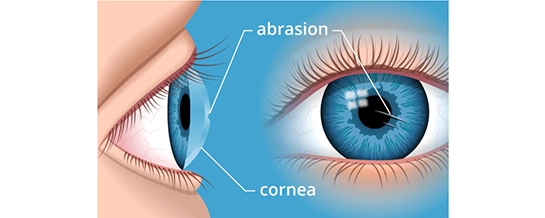How to Care for Your Child with Corneal Abrasion
This leaflet will provide you with information about Corneal Abrasion causes, symptoms, diagnosis, treatment and home care advice.

What is Corneal Abrasion?
The cornea is a clear protective layer in the front of the eye. An abrasion is a scratch of this layer (cornea) caused by a hard object like fingernail, wood, metal, glass or sometimes contact lenses
What are the symptoms of Corneal Abrasion?
Your child may experience the following:
- Pain and sensitivity to the light and unable to open his eye
- A gritty feeling in the eye
- Excessive tearing and burning sensation
- Redness of the eye
- Headache
How is Corneal Abrasion diagnosed?
The doctor will examine your child and check his/her vision. Then may apply an eye drops containing pain medicine and another one containing a yellow die to your child's eye. This will help the doctor to see the scratch with a special lamp. If the doctor finds an object under the eyelid, then this will be removed.
How is Corneal Abrasion treated?
Most corneal abrasions heal very well within two days. The doctor may give your child an antibiotic drop or ointment; make sure you use them as directed.
If your doctor advises giving your child medicine for pain, you can give him/her the following:
- Paracetamol (any brand) Or, Ibuprofen (any brand)
- Follow the instruction on the medicine package for the correct dose for your child
- Do not give Aspirin to your child as this can cause a serious complication
Home care advice
- Do not try to remove an object that is embedded in your child eyeball
- Ensure that your child does not rub his/her eye after an injury.
- Do not touch your child eyeball with cotton swabs, tweezers or other instruments.
- If your child uses contact lenses, do not allow your child to wear them while the eye is healing.
- Avoid bright light or get your child to wear sunglass when going outside
When should I seek medical advice?
Seek medical care if your child:
- Has yellow or green discharge from his/her eye
- Has ongoing pain
Go to the Emergency Department if your child:
- Is unable to open his/her eye
- Can not see normally

